Hardwood Floor Sanding: The Details You’re Ignoring
Like most of us, you’ve probably heard about the benefits of DIY refinishing hardwood floors. Homeowners frequently commit to DIY Floor Sanding Melbourne projects only to be disappointed with the results.
However, hiring a professional floor sanding specialist will save you time, money, and hassle while providing a higher quality, longer-lasting finish. Especially when it comes to sanding and finishing hardwood floors, the small details make a big difference.
Suppose you choose DIY floor sanding and end up with poor results. Have you ever considered how many details you are missing? Whether you are refinishing your entire floor or just a section, skipping the following steps will result in poor results.
hammering the nails
During the sanding process, most homeowners skip this step. Punching down protruding nails fastens not only any loose boards but also creates a better sanding environment. Unset nails can cause sanding lines on your hardwood floor by damaging the sandpaper.

Sanding lines are typically not visible until the floor has been stained. They are frequently unappealing and indicate a poorly executed project.
However, if you consider hiring a professional Floor Sanding Melbourne, particularly if your boards are old and damaged or if you intend to cover a large area, moving and storing belongings and furniture while the work is being done can be inconvenient, especially if you are doing it yourself in your spare time. DIY projects always take longer than expected.
Sanding against the grain
Sanding against the grain is an essential part of floor sanding that many homeowners do not realize. It is also one of the most difficult parts of floor sanding, as it requires a lot of patience and finesse. A skilled professional will know how to do this without damaging your floors or leaving any visible marks behind.
If you don’t have access to a sander, you can rent one at your local home improvement store or use any fine grit sandpaper and start sanding your wood floor by hand. But keep in mind that doing so takes longer than renting or buying an electric machine with built-in dust removal features (which means less mess).
Plus, if you don’t know what you are doing with regard to the proper technique for finishing the job properly, there’s no telling what kind of damage could be done!
Vacuuming before applying wood filler
- Vacuum the floor. You will need to vacuum your hardwood floor to remove any dust and debris that may have accumulated on it.
- Use a soft brush attachment on your vacuum. Once you have vacuumed all of the dust from your hardwood, use a crevice tool with a soft brush attachment to clean along the edges and corners of any furniture that is in the room.
Hand sanding after scraping the floor
When sanding hardwood floors, it is necessary to scrape the floor in inaccessible areas. However, it is insufficient to provide the desired high-quality finish. Hand sanding should be done after scraping the floor to create a smooth base for the application of finish for a nice smooth surface.
Scraping furniture, foot traffic, and sunlight can all damage your wooden floors, no matter how careful you are. The sanding process removes these marks, making them appear new. Sanding the floors can also address more serious damage, such as cupping and bowing, though this will require the assistance of a flooring expert.
Conclusion
Nothing beats the look of beautiful timber flooring; if you’re fortunate enough to have them in your home, they’ll truly stand the test of time. Total Floor Service provides expert flooring sanding Melbourne and takes pride in restoring the aesthetic of your timber flooring. Our skilled in-house finishing team restores your floors to the highest standards, and we offer a variety of exclusive finishes for you to choose from.











 Address:
Address:  Phone:
Phone:  ABN: 63 602 512 489
ABN: 63 602 512 489




